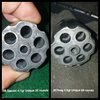Typetwelve
Member
- Joined
- Mar 1, 2019
- Messages
- 644
Ok...so the "facts":
S&W 629, 4" barrel. I measured every cylinder and they're all a very consistent .429"
I started with these projectiles here:
https://summersenterprisesllc.com/product/44-240gr-430-500-ct-box/
I measured these and they are as advertised, .430". If you do not want to scroll down on , they are 18 hardness, which I understand is not very soft.
When I was loading these fellas with 5-6.5 grains of Unique, the were leading BADLY. I tried making Skeeters out of them over 7.5 grains of Unique, but they're still leading really bad. The leading is at the forcing cone and right into the barrel, not in the middle or end.
By what I understand, with an undersized cyl throat, being .001" oversized, these shouldn't be leading this badly.
Any thoughts or suggestions?
S&W 629, 4" barrel. I measured every cylinder and they're all a very consistent .429"
I started with these projectiles here:
https://summersenterprisesllc.com/product/44-240gr-430-500-ct-box/
I measured these and they are as advertised, .430". If you do not want to scroll down on , they are 18 hardness, which I understand is not very soft.
When I was loading these fellas with 5-6.5 grains of Unique, the were leading BADLY. I tried making Skeeters out of them over 7.5 grains of Unique, but they're still leading really bad. The leading is at the forcing cone and right into the barrel, not in the middle or end.
By what I understand, with an undersized cyl throat, being .001" oversized, these shouldn't be leading this badly.
Any thoughts or suggestions?


